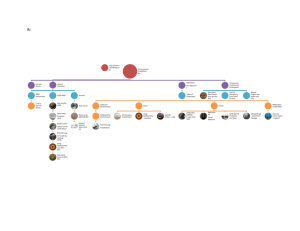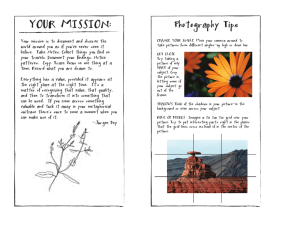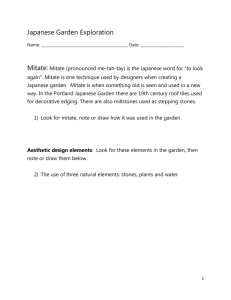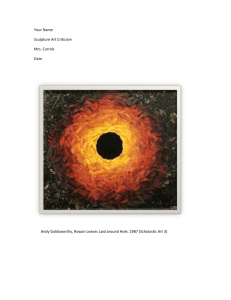background information.
advertisement
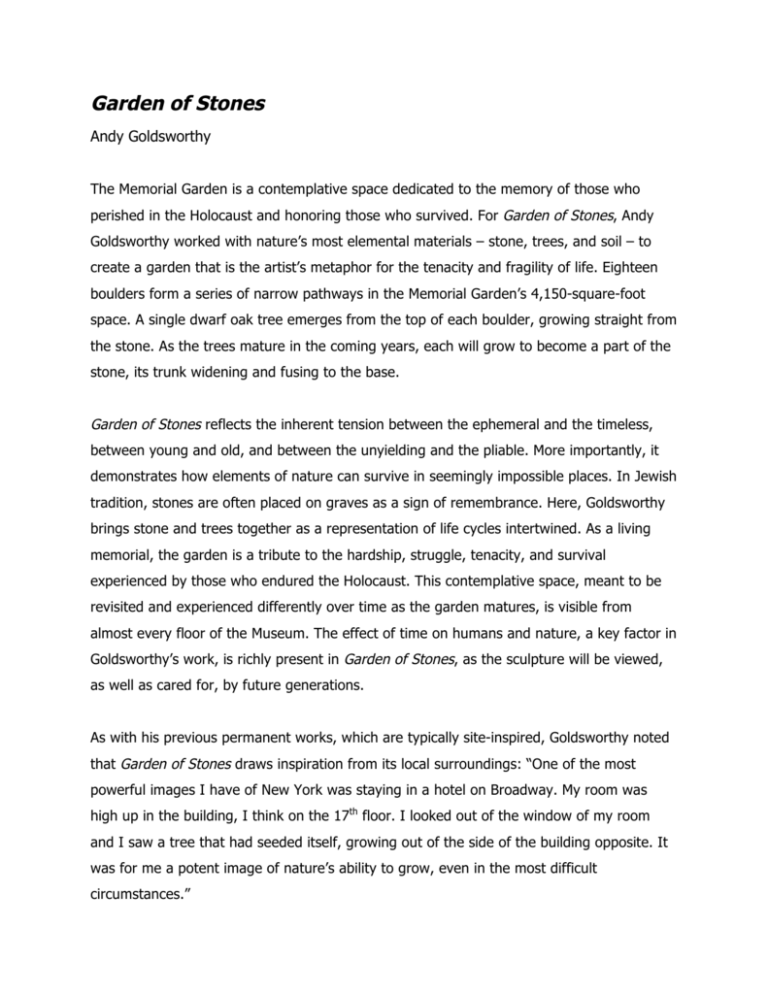
Garden of Stones Andy Goldsworthy The Memorial Garden is a contemplative space dedicated to the memory of those who perished in the Holocaust and honoring those who survived. For Garden of Stones, Andy Goldsworthy worked with nature’s most elemental materials – stone, trees, and soil – to create a garden that is the artist’s metaphor for the tenacity and fragility of life. Eighteen boulders form a series of narrow pathways in the Memorial Garden’s 4,150-square-foot space. A single dwarf oak tree emerges from the top of each boulder, growing straight from the stone. As the trees mature in the coming years, each will grow to become a part of the stone, its trunk widening and fusing to the base. Garden of Stones reflects the inherent tension between the ephemeral and the timeless, between young and old, and between the unyielding and the pliable. More importantly, it demonstrates how elements of nature can survive in seemingly impossible places. In Jewish tradition, stones are often placed on graves as a sign of remembrance. Here, Goldsworthy brings stone and trees together as a representation of life cycles intertwined. As a living memorial, the garden is a tribute to the hardship, struggle, tenacity, and survival experienced by those who endured the Holocaust. This contemplative space, meant to be revisited and experienced differently over time as the garden matures, is visible from almost every floor of the Museum. The effect of time on humans and nature, a key factor in Goldsworthy’s work, is richly present in Garden of Stones, as the sculpture will be viewed, as well as cared for, by future generations. As with his previous permanent works, which are typically site-inspired, Goldsworthy noted that Garden of Stones draws inspiration from its local surroundings: “One of the most powerful images I have of New York was staying in a hotel on Broadway. My room was high up in the building, I think on the 17th floor. I looked out of the window of my room and I saw a tree that had seeded itself, growing out of the side of the building opposite. It was for me a potent image of nature’s ability to grow, even in the most difficult circumstances.” Garden of Stones: The Process Goldsworthy began working on the Garden of Stones in late 2002. In the winter and early spring of 2003, he traveled to forests and quarries in the northeastern United States seeking out suitable boulders, which he located in Barre, Vermont. Searching for boulders that were free of flaws, Goldsworthy selected stones that range in size and physical character. He noted that “there is an energy within a group of stones of various sizes. It becomes a family.” The smallest stone is three tons, while the largest weighs more than 13 tons. Most of the boulders he selected had been removed from nearby farmlands hundreds of years ago, something that appealed to Goldsworthy since there was a tradition of human involvement with the stone. “My working of the stones is a continuation of the journey these stones have made. They have a history of movement, struggle, and change which I hope will resonate with the garden.” He chose to include eighteen boulders in part because of the number’s symbolic significance: In Hebrew every letter also possesses a number value. Chai, whose number value is 18, is the Hebrew word for life, and is known to many in the traditional toast “L’chaim” – to life! In all of Goldsworthy’s works, the process of selecting and becoming familiar with the natural materials he uses is a key element of the work itself. For Garden of Stones, he researched several different methods of hollowing the stones, including coring, water jet cutting, and burning with a flame torch. “I rarely repeat a work twice, so each work is a step into the unknown,” he has said. He chose the flame torch method, in part because it was the most efficient, but also because granite is a fire-formed stone: Goldsworthy saw an affinity between the way the stone came into being and the way in which it became part of Garden of Stones. This spectacular technique melted away the interior of the stones, transforming solid granite into molten liquid. For the trees, Goldsworthy selected a species of dwarf oak, Quercus prinoides. The trees will begin as small saplings, and over the course of decades will grow to be around 12 feet tall. “Amidst the mass of stone the trees will appear as fragile, vulnerable flickers of life – an expression of hope for the future. The stones are not mere containers. The partnership between tree and stone will be stronger for having grown from the stone.” Goldsworthy is most known for his fleeting works with nature. “I try whenever possible to make one or two ephemeral works each day,” Goldsworthy has said. But his permanent works are “much more thought-out and reasoned….I take seriously the responsibility of leaving behind something that will last a long time.” Garden of Stones, while using stone, one of nature’s more immutable materials, is balanced by the delicacy of the young tree. In no other of Goldsworthy’s permanent commissions is there such a marriage of the ephemeral and the timeless. Goldsworthy was selected for this major commission from a group of more than 60 internationally known artists. The Museum and Public Art Fund collaborated on the Memorial Garden selection process, inviting artists and landscape architects to submit materials for consideration. Five artists were commissioned to make full proposals by a panel that included input from the Trustees of the Museum, Holocaust survivors, and members of the larger community. The artist competition was funded by Museum Trustee Michael Steinhardt. In 2009, the Museum of Jewish Heritage created an installation that captures the garden over time, through the seasons. Timekeeper allows visitors to view the garden through time-lapse photography, to see the growth of the garden when they themselves are not there to witness it. The installation includes videos showing Goldsworthy’s process of choosing, hollowing, and placing the stones, and the planting of the trees by Holocaust survivors and their families. Timekeeper is located in the Pickman Keeping History Center on the 3rd floor. About Andy Goldsworthy Andy Goldsworthy is known for his outdoor sculptural interventions and indoor installations that transform nature’s most familiar elements into graceful designs. Using color and geometric form to order found materials – such as stone, trees, mud, grass, snow, ice, and leaves – Goldsworthy creates visual displays in which the changing nature of the materials is as much a part of the work as the design itself. With their apparent effortlessness, Goldsworthy’s creations impart a sense of wonder, drawing attention to the inherent power, beauty, and mystery of nature. The simplicity of each work belies its labor-intensive origins, the hours spent gathering stones of a certain type, layering colored leaves into a circle, or patiently waiting as a circle of water freezes to ice. Andy Goldsworthy was born in Cheshire, England in 1956. Since the 1970s, he has been making sculptures and installations with and about nature. Solo museum exhibitions of his work have been held in the Setagaya Art Museum, Japan (1994); the Barbican Centre, London (2000); Site Santa Fe, New Mexico (2000); the Museum of Contemporary Art, San Diego (2002); and elsewhere around the world. His other major permanent commissions in the United States include Storm King Wall (1995-97) at Storm King Art Center, River (2000) at Stanford University, Three Cairns (2002) at the Des Moines Art Center, Roof (2004-2005) at the National Gallery of Art, Washington, DC, and Drawn Stone (2005) at the De Young Museum, Fine Arts Museums of San Francisco. Andy Goldsworthy was the subject of the award-winning documentary by Thomas Riesshleimer, Rivers and Tides. In New York he is represented by Galerie Lelong. For more information about the Garden and the Museum, please visit www.mjhnyc.org/garden.
